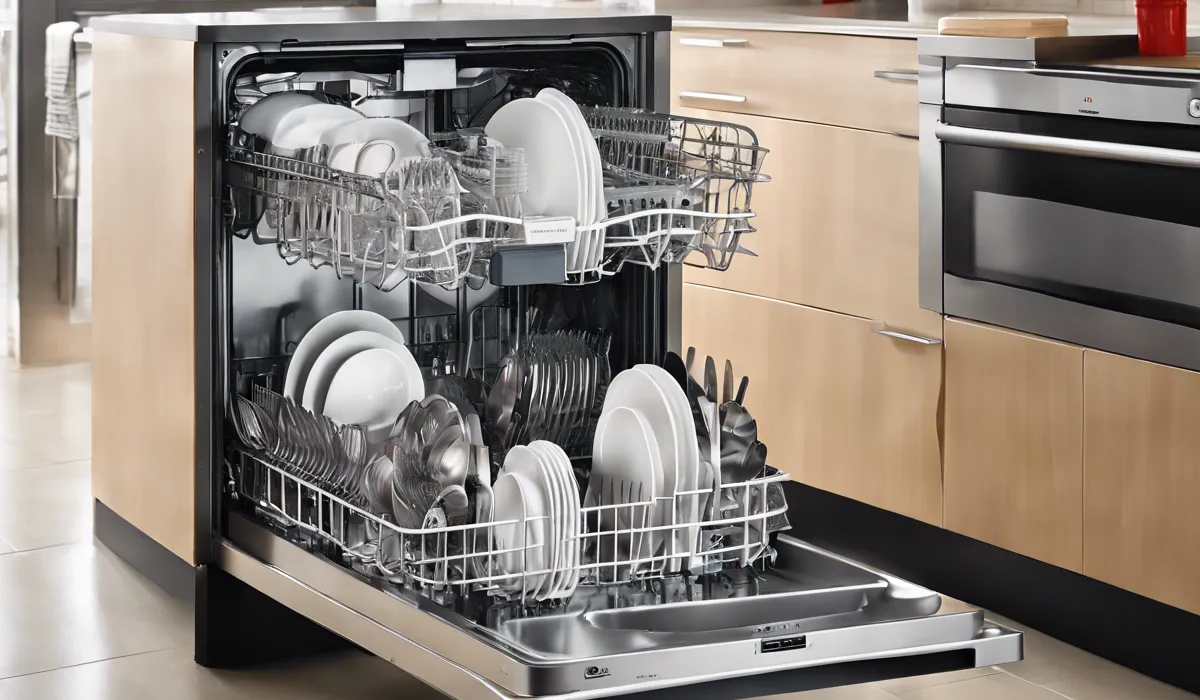How to Load a Dishwasher: Maximize Cleanliness & Space!
To load a dishwasher, place plates in the bottom rack, facing the center. Put glasses and mugs on the top rack, angled to avoid water pooling. Position cutlery in the utensil basket, handle down. Avoid blocking spray arms for optimal cleaning.
Preparation Before Loading the Dishwasher

Removing Food Scraps
Start by scraping off large pieces of food from your dishes into the trash or compost bin. This step is crucial because it prevents the filter from clogging and ensures that water can flow freely during the wash cycle.
You don’t need to worry about the tiny particles, as the dishwasher is designed to handle those. But removing big chunks of food will make a significant difference in how clean your dishes come out.
Pre-Rinsing Practices
If your dishes have stuck-on food or grease, a quick pre-rinse can help. This doesn’t mean you should wash the dishes completely, but a quick spray under the tap to remove the excess can improve your dishwasher’s performance.
However, for some modern dishwashers that are designed to detect how dirty your dishes are, pre-rinsing might not be necessary. Check your user manual to see what’s recommended for your model.
Inspecting the Dishwasher Interior
Before you load any dishes, take a moment to inspect the inside of your dishwasher.
Look for any food residues or objects that might have been left behind from the last cycle.
If there’s anything there, remove it to prevent it from sticking to your clean dishes or hindering the effectiveness of the next cycle.
Ensuring a Clean Filter
The filter is where all the food particles are collected, and a clean filter is essential for the dishwasher to work correctly.
Most dishwashers have a removable filter that you can take out and rinse under running water.
Do this regularly to avoid unpleasant odors and maintain your dishwasher’s efficiency. Make sure to place the filter back correctly before starting your dishwasher.
Loading the Dishwasher Properly

Organizing Large Items
When loading the dishwasher, start with the large items. Pots, pans, and dinner plates should go on the bottom rack.
Position them so that their dirty surfaces face the water spray, which is typically towards the center. Be careful not to block the water jets with large items, as this could prevent other dishes from getting clean.
Arranging Glasses and Mugs
Place your glasses and mugs on the top rack. They should be upside down and angled to allow water to reach the inside and then drain out. Be sure to space them apart to prevent them from knocking into each other and possibly breaking during the wash cycle.
Positioning Silverware Correctly
Your cutlery goes into the utensil basket. Put knives, forks, and spoons with their handles facing down so the water can reach the dirty part.
Mixing up the utensils can prevent them from nesting together, which sometimes happens with spoons, ensuring a better clean. Just be cautious with sharp knives to prevent injury when you’re unloading.
Loading Bowls and Plates at an Angle
For bowls and plates, angle them on the rack so that the water spray can reach inside the bowls and over the entire surface of the plates.
This angled position helps the water and detergent to circulate effectively, giving you a better result.
Avoiding Nesting and Overlapping
It’s important to avoid nesting or overlapping items, as this can prevent the water and detergent from reaching all surfaces.
Each dish should have its own space in the rack. This is particularly key for items with concave surfaces, like bowls or cups, where water can pool if they are stacked together.
Ensuring Freedom of Movement for Spray Arms
After loading your dishwasher, gently spin the spray arms to make sure they can move freely.
If they hit any dishes, rearrange those items. The spray arms need to rotate without obstruction to distribute water and detergent evenly during the wash cycle.
Optimizing Dishwasher Performance

Choosing the Right Wash Cycle
Dishwashers come with various cycles, from heavy-duty for pots and pans to light wash for delicate items.
Choose the appropriate cycle based on how dirty your dishes are and the load size. Using the right cycle not only cleans your dishes effectively but also saves water and energy.
Measuring Dishwasher Detergent
The amount of detergent you use should be based on the manufacturer’s recommendation.
Too little won’t get your dishes clean, while too much can leave a residue. If you have hard water, you might need to use a little extra detergent to get the best results.
Using Rinse Aid for Spotless Results
A rinse aid can be a game-changer, especially if you have hard water. It helps to remove water from your dishes more efficiently during the final rinse, preventing water spots and streaks.
If you want your glasses and plates to come out of the dishwasher looking sparkling clean, consider adding rinse aid to each cycle.
Energy and Water Efficiency
To get the most out of your dishwasher while being eco-friendly, only run it when it’s fully loaded.
This practice maximizes the use of water and energy per dish. Plus, loading the dishwasher efficiently by following the guidelines above can reduce the need for extra cycles, saving even more resources.
Running a Full Load
Operate your dishwasher only when it’s full to ensure maximum efficiency. This doesn’t mean you should overstuff it, as that can compromise the cleaning.
But by running it only when full, you make the best use of the water and energy consumed per cycle, making it both economical and environmentally friendly.
FAQs About Loading a Dishwasher
How should I position plates in the dishwasher for the best cleaning results?
Place plates in the bottom rack of the dishwasher, ensuring they are facing the center for optimal water and detergent exposure.
What is the correct way to load glasses and mugs in the dishwasher?
Glasses and mugs should be placed on the top rack, angled properly to prevent water from pooling and ensure thorough cleaning.
Where should cutlery be placed in the dishwasher?
Cutlery should be positioned in the utensil basket with handles facing down, except for sharp knives which should be placed handle up for safety.
Is there a specific way to load utensils in the dishwasher to avoid nesting?
Yes, mix different types of cutlery in the basket to prevent nesting and ensure all surfaces are exposed to the washing process.
What should I avoid placing in the dishwasher to ensure the spray arms work effectively?
Avoid blocking the spray arms with large items or overcrowding the dishwasher; this ensures all items are cleaned properly by allowing the spray arms to rotate freely.
Final Thoughts
Effectively loading a dishwasher involves strategic placement of items: plates on the bottom rack facing inward, glasses and mugs on the top rack tilted to prevent water accumulation, and cutlery in the utensil basket with handles down.
It’s crucial to ensure that the spray arms are unobstructed to guarantee thorough cleaning.





